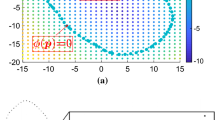Abstract
We present a new method capable of inferring, for the first time, inter-particle contact forces in irregularly-shaped natural granular materials (e.g., sands), using basic Newtonian mechanics and balance of linear momentum at the particle level. The method furnishes a relationship between inter-particle forces and corresponding average particle stresses, which can be inferred, for instance, from measurements of average particle strains emanating from advanced experimental techniques (e.g., 3D X-ray diffraction). Inter-particle forces are the missing link in understanding how forces are transmitted in complex granular structures and the key to developing physics-based constitutive models. We present two numerical examples to verify the method and showcase its promise.
Similar content being viewed by others
References
Andrade J.E., Borja R.I.: Capturing strain localization in dense sands with random density. Int. J. Numer. Methods Eng. 67, 1531–1564 (2006)
Andrade J.E., Ellison K.C.: Evaluation of a predictive constitutive model for sands. J. Geotech. Geoenviron. Eng. 134, 1825–1828 (2008)
Dafalias Y.F., Popov E.P.: A model of nonlinearly hardening materials for complex loadings. Acta Mech. 21, 173–192 (1975)
Grueschow E., Rudnicki J.W.: Elliptic yield cap constitutive modeling for high porosity sandstone. Int. J. Solids Struct. 42(16–17), 4574–4587 (2005)
Manzari M.T., Dafalias Y.F.: A critical state two-surface plasticity model for sands. Géotechnique 43, 255–272 (1997)
DiMaggio F.L., Sandler I.S.: Material model for granular soils. J. Eng. Mech. Div. ASCE 97, 935–950 (1971)
Bažant Z.P., Caner F.C., Carol I., Adley M.D., Akers S.A.: Microplane model M4 for concrete. I: formulation with work-conjugate deviatoric stress. J. Eng. Mech. 126, 944–953 (2000)
Schofield A., Wroth P.: Critical State Soil Mechanics. McGraw-Hill, New York (1968)
Cundall P.A., Strack O.D.L.: A discrete numerical model for granular assemblies. Géotechnique 29, 47–65 (1979)
Bardet J.P., Proubet J.: Adaptive dynamic relaxation for statics of granular materials. Comput. Struct. 39, 221–229 (1991)
Rothenburg L., Bathurst R.J.: Analytical study of induced anisotropy in idealized granular materials. Géotechnique 39, 601–614 (1989)
Jensen R.P., Bosscher P.J., Plesha M.E., Edil T.B.: DEM simulation of granular media—structure interface: effect of surface roughness and particle shape. Int. J. Numer. Anal. Methods Geomech. 23, 531–547 (1999)
Tu X., Andrade J.E.: Criteria for static equilibrium in particulate mechanics computations. Int. J. Numer. Methods Eng. 75, 1581–1606 (2008)
Oda M., Takemura T., Takahashi M.: Microstructure in shear band observed by microfocus X-ray computed tomography. Géotechnique 54, 539–542 (2004)
Alshibli K.A., Sture S., Costes N.C., Frank M.L., Lankton F.R., Batiste S.N., Swanson R.A.: Assessment of localized deformations in sand using X-ray computed tomography. Geotech. Test. J. ASCE 23, 274–299 (2000)
Ketcham R.A., Carlson W.D.: Acquisition, optimization and interpretation of X-ray computed tomographic imagery: applications to the geosciences. Comput. Geosci. 27, 381–400 (2001)
Wang L., Park J.Y., Fu Y.: Representation of real particles for DEM simulation using X-ray tomography. Constr. Build. Mater. 21, 338–346 (2005)
Poulsen H.F.: Three-Dimensional X-Ray Diffraction Microscopy: Mapping Polycristals and their Dynamics. Springer, New York (2004)
Hall S.A., Bornert M., Desrues J., Pannier Y., Lenoir N., Viggiani G., Bésuelle P.: Discrete and continuum analysis of localized deformation in sand using X-ray micro CT and volumetric digital image correlation. Géotechnique 60, 315–322 (2010)
Andrade J.E., Avila C.F., Lenoir N., Hall S.A., Viggiani G.: Multiscale modeling and characterization of granular matter: from grain scale kinematics to continuum mechanics. J. Mech. Phys. Solids 59, 237–250 (2011)
Martins R.V., Margulies L., Schmidt S., Poulsen H.F., Leffers T.: Simultaneous measurement of the strain tensor of 10 individual grains embedded in an Al tensile sample. Mater. Sci. Eng. A 387(389), 84–88 (2004)
Hall, S.A., Wright, J., Pirling, T., Andò, E., Hughes, D.J., Viggiani, G.: Can intergranular force transmission be identified in sand? Granul. Matter (2011). doi:10.1007/s10035-011-0251-x
Christoffersen J., Mehrabadi M.M., Nemat-Nasser S.: A micromechanical description of granular material behavior. J. Appl. Mech. 48, 339–344 (1981)
Drescher A., de Josselin de Jong G.: Photoelastic verification of a mechanical model for the flow of a granular material. J. Mech. Phys. Solids 20, 337–340 (1972)
Majmudar T.S., Behringer R.P.: Contact force measurements and stress-induced anisotropy in granular materials. Nature 435, 1079–1082 (2005)
Frocht M.M.: Photoelasticity, vol. 1. Wiley, New York (1941)
Frocht M.M.: Photoelasticity, vol. 2. Wiley, New York (1941)
Pellegrino S.: Structural computations with the singular value decomposition of the equilibrium matrix. Int. J. Solids Struct. 30, 3025–3035 (1993)
Holzapfel G.A.: Nonlinear Solid Mechanics. Wiley, West Sussex (2000)
Peña A.A., Lind P.G., Herrmann H.J.: Modeling slow deformation of polygonal particles using dem. Particuology 6, 506–514 (2008)
Hughes T.J.R.: The Finite Element Method. Prentice-Hall, Englewood Cliffs (1987)
Strang G.: Linear Algebra and Its Applications. 3rd edn. Thomson Learning, London (1988)
Belytschko T., Liu W.K., Moran B.: Nonlinear Finite Elements for Continua and Structures. Wiley, West Sussex (2000)
Bardet J.P., Vardoulakis I.: The asymmetry of stress in granular media. Int. J. Solids Struct. 38, 353–367 (2001)
Peters J.F., Muthuswasmy M., Wibowo J., Tordesillas A.: Characterization of force chains in granular material. Phys. Rev. E 72, 041397 (2005)
Author information
Authors and Affiliations
Corresponding author
Rights and permissions
About this article
Cite this article
Andrade, J.E., Avila, C.F. Granular element method (GEM): linking inter-particle forces with macroscopic loading. Granular Matter 14, 51–61 (2012). https://doi.org/10.1007/s10035-011-0298-8
Received:
Published:
Issue Date:
DOI: https://doi.org/10.1007/s10035-011-0298-8




